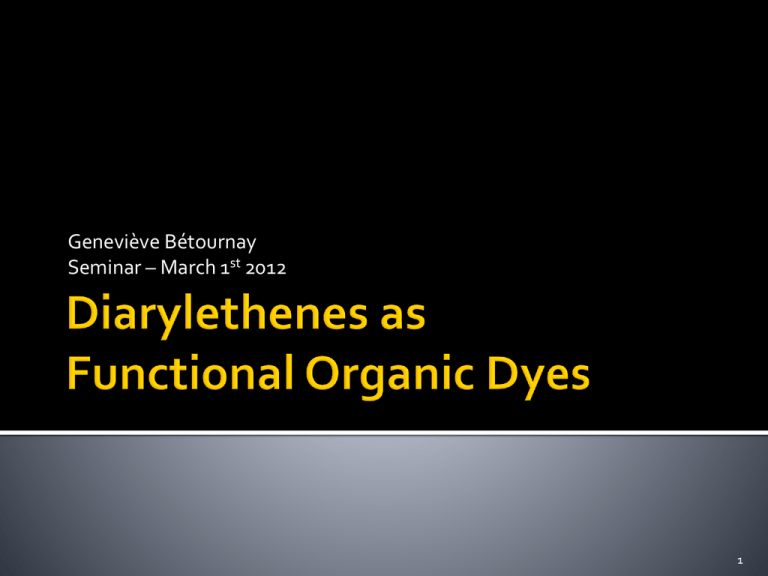Diarylethenes as Functional Organic Dyes
advertisement

Geneviève Bétournay Seminar – March 1st 2012 1 General introduction to functional dyes Introduction to photochromic dyes Specific Applications Diarylethenes and their properties Diarylethene syntheses Conclusion 2 Colorants absorb or emit light in the visible range (400-700 nm) Dyes and pigments Organic and inorganic Natural and synthetic Traditional applications Textiles, paints and plastics Food Cosmetics and hair dyes R N R2 N S O O O H 2O N Cr N N Ar O O R O O OH OH O Alizarin Magenta Polaroid SX-70 system R1 N H 2N N NH R2 Mauveine 1856 rd Zollinger, H. Color Chemistry, 3 ed; VHCA, Wiley-VCH: Zürich, Weinheim, 2003. Sir William Henry Perkin 3 Biomedical and biochemical Tagging, Imaging Military uses IR Camouflage Security Security printing Dye Lasers Cameras Ink-jet printers Colour display devices OLEDs Dye Sensitized Solar Cells (DSSC) Ophthalmic lenses 4 Molecule that reversibly changes between two or more states in response to an external stimulus (Temperature, light, electrical current, pH, etc...) Optical switch when the stimulus is light 1 Molecular computers, supramolecular chemistry, telecommunications Device for recording and storing digital information (binary), written and read by a laser CDs, DVDs, Blu-ray Photochromic dyes 5 UV Vis. H. Dürr, H. Bouas-Laurent Pure Appl. Chem. 2001, 73, 639. 6 R N N hv 1 N N hv 2 or E-Z isomerization Intramolecular hydrogen transfer Intramolecular group transfer Dissociation processes Electron transfer R R R hv 1 N N H OH O O O hv 1 hv 2 or O O O O O O hv R 2N NR 2 R 2N NR 2 CN CN M, hv R N N R M+, R N H. Dürr, H. Bouas-Laurent Pure Appl. Chem. 2001, 73, 639. NHR 7 Pericyclic reactions – usually electrocyclizations R hv 1 X X hv2 or N O R Spiropyrans (X = C) and N O Spirooxazines (X = N) hv 1 O Chromenes hv 2 or O O O hv 1 O X X hv 2 O O O Fulgimides (X = N) F F F F F F Fulgides (X = O) and F F hv 1 F F F F S S Diarylethenes hv 2 S S H. Dürr, H. Bouas-Laurent Pure Appl. Chem. 2001, 73, 639. 8 1867 Fritzsche - photochromism of tetracene 40s – 60s Mechanistic and synthetic studies, especially by Hirschberg and Fischer 1950 Hirschberg suggests the term “photochromism” 1952 Discover photochromism of spiropyrans 1956 Hirschberg compares photochromic systems to information stored and removed from a memory Expansion in late 60s, revival in 80s H. Dürr, H. Bouas-Laurent Pure Appl. Chem. 2001, 73, 639. Zollinger, H. Color Chemistry, 3rd ed; VHCA, Wiley-VCH: Zürich, Weinheim, 2003. Hirschberg, Y. J. Am. Chem. Soc. 1956, 78, 2304. 9 1989 from Transitions Optical, Inc. Biggest consumer of photochromic dyes Cocktail of carefully matched compounds R hv 1 N These are T-type compounds (Thermally reversible) N O R hv 2 or N N O Compounds will slowly revert back to the colourless form hv 1 O hv 2 or O Corns, S. N., Partington, S. M. Towns, A. D. 2009, Color. Tech., 2009, 125, 249. Zollinger, H. Color Chemistry, 3rd ed; VHCA, Wiley-VCH: Zürich, Weinheim, 2003. 10 11 Photo-optical switching: information Change in the refractive index switch UV Vis. Switching the route of optical fiber networks F F F F Photoelectrochemical switching: N Change in electrochemical properties S S UV Modulation in molecular electronic devices N Vis. F F F F N Irie, M. Chem. Rev. 2000, 100, 1685. F F S F F S N 12 Greater data density storage 2 mm3 CD: 700 MB Faster transfer rate Toriumi, A., Herrmann, J. M., Kawata, S. Opt. Lett. 1997, 22, 555. 13 Thermal stability of both isomers Low fatigue Reaction induction at desired wavelengths Rapid response and high sensitivity Non destructive readout capability (Memories) H. Dürr, H. Bouas-Laurent Pure Appl. Chem. 2001, 73, 639. Zollinger, H. Color Chemistry, 3rd ed; VHCA, Wiley-VCH: Zürich, Weinheim, 2003. 14 15 Thermal stability is very important for optoelectronic applications T-type (thermally reversible) photochromic compounds can’t be used... information switch Δ Δ 16 Reverse reaction only happens with light, thermally irreversible R1 R R2 R3 O R X R4 Ar Ar O Fulgides (X = O) Fulgimides (X = N) Diarylethenes 1981 – Heller et al. report P-type fulgides Diarylethenes are the most promising candidates for optoelectronic applications Zollinger, H. Color Chemistry, 3rd ed; VHCA, Wiley-VCH: Zürich, Weinheim, 2003. 17 Long lifetime without light and O2 UV X X Masahiro Irie O2 vis. X X = O, S X X X X = O, S Thermally unstable Reverts back quickly in the dark O2 UV vis. or UV O2 vis X X X = O, S X X X X X = O, S Kellogg, R. M., Green, M. B., Wynberg, H. J. Org. Chem. 1967, 32, 3093. Muszkat, K. A., Fischer, E. J. Chem. Soc. B, 1967, 662. Irie, M., Mohri, M. J. Org. Chem. 1988, 53, 803. 18 T-type P-type Aryl Group Relative Ground State Energy Difference (conrotatory, kcal/mol) Aromatic Stabilization Energy (kcal/mol) Half-life of closed-ring isomer* in the dark (temp.) Phenyl 27.3 27.7 1.5 min (20 °C) Pyrrolyl 15.5 13.8 32 min (20 °C) Furyl 9.2 9.1 >12 h (80 °C) Thienyl -3.3 4.7 >12 h (80 °C) * Derivatives Nakamura, S., Irie, M. J. Org. Chem. 1988, 53, 6136 Patel, P. D., Masunov, A. E. J. Phys. Chem. C 2011, 115, 10292. 19 R R R R R R R R R N N R S S X S X X X S S X X = O or S R N R N N Irie, M. Proc. Jpn Acad. Ser. B 2010, 86, 472. Irie, M. Chem. Rev. 2000, 100, 1685. R R S S N OHC R R S S CHO R R S iPr S iPr 20 21 Undesireable side reactions limit the number of cycles S R R hv R X S NC NC CN O2 R UV S S S S S O F F F F hv Ph S F F S S O S F F S CN S F F F F UV Ph Ph S S Ph S Hanazawa, M., Sumiya, R., Horikawa, Y., Irie, M. J. Chem. Soc. Chem. Comm. 1992, 206. Irie, M., Lifka, T., Uchida, K., Kobatake, S., Shindo, Y. Chem. Comm. 1999, 747. Taniguchi, H., Shinpo, A., Okazaki, T., Matsui, F., Irie, M. Nippon Kagaku Kaishi 1992, 1138. 22 F F F F F F F F S F F F F UV S F F S Ring-closed isomer O O F F S F F S S F F F F F F S F F S Repeatable Cycles Number* (in Benzene) In Air Under Vacuum O 70 S F F F F S S F F F F F F 480 S S O O 3700 S S O 10 000 S * The number of photochromic cycles at which the absorbance of the closed-ring isomer is 80% of its value in the first cycle. Irie, M., Lifka, T., Uchida, K., Kobatake, S., Shindo, Y. Chem. Comm. 1999, 747. Irie, M. Pure & Appl. Chem. 1996, 1367. Higashiguchi, K., Matsudo, K., Kobatake, S., Yamada, T., Kawai, T., Irie, M. Bull. Chem. Soc. Jpn 2000, 2389. 23 24 Specific applications require specific wavelengths Depends on light source that will be used Near-Field Optical Memory: conventional laser lights ▪ Writing with 488 nm light (Ar ion laser) ▪ Erasing with 633 nm light (He-Ne laser) Change the compound’s structure in order to change its maximum absorbance (λmax) 25 Dependant on upper cycloalkene unit EWG increase λmax Perfluorocyclopentene derivatives have λmax in the UV region Maleic anhydride and maleimide derivatives have λmax > 400 nm F F F F F F S S 258 nm O O S O S 417 nm Bn N O S O S 406 nm Hanazawa, M., Ritsuo, S., Horiikawa, Y., Irie, M. J. Chem. Soc. Chem. Commun. 1992, 206 (Perfluorocyclopentene) Uchida, K., Nakayama, Y., Irie, M. Bull. Chem. Soc. Jpn 1990, 63, 1311. (Maleic anhydride) El Yahyaoui, A., Félix, G., Heynderickx, A., Moustrou, C., Samat, A. Tetrahedron 2007, 63, 9482. (Maleimide) 26 Extent of π-electron delocalization F F F F F F F F S F F F F F F S F F S S 425 nm F F S 469 nm S 534 nm Ring substituents have a big impact F F F F F F F F F F F F F F S S F F F F S S S S Et2N 534 nm Irie, M. Chem. Rev. 2000, 100, 1685. 562 nm NEt2 597 nm 27 O O S O O O N S 550 nm O N N 620 nm O O O O O S 578 nm Thermally unstable O O O Thermally stable O O O MeO O MeO N S 534 nm Irie, M. Chem. Rev. 2000, 100, 1685. N S 562 nm CN N S CN 597 nm 28 29 How quickly the reaction occurs upon irradiation Both cyclization and cycloreversion generally happen ≤ 10 picoseconds Pico- and femtosecond laser photolysis experiments How many reactions occur with a given amount of energy (light) Quantified by and dependent on: ε - Molar absorption coefficient Φ - Quantum Yield Miyasaka, H., Arai, S., Tabata, A., Nobuto, T., Mataga, N., Irie, M. Chem. Phys. Lett. 1991, 230, 249. (Laser photolysis studies) 30 For a any given compound: Measure of how much light is absorbed at a given wavelength (M-1cm-1) Intrinsic property F F F F F F S Electron rich substituents S Et2 N NEt2 F F F F F F S Large π-conjugation ε S Irie, M., Sakemura, K., Okinaka, M., Uchida, K. J. Org. Chem. 1995, 8305. (electron donating groups) Bens, A. T., Frewert, D., Kodatis, K., Kryschi, C., Martin, H.-D., Trommsdorf, H. P. Eur. J. Org. Chem. 1998,, 2333. (polyene) 31 F F F F F F # chemical reactions F F S F F F vis # photons absorbed UV F S S S Antiparellel : Parallel ~ 1 : 1 Photocyclization can only proceed from the antiparallel conformation Maximum φ for ring closure is ~ 0.50 Increase amount of antiparallel conformer Irie, M. Chem. Rev. 2000, 100, 1685. 32 Bridging the two thiophene units at 4 and 4’ positions (cyclophane) Compound Φcyclization UV Not bridged 0.40 vis Bridged 0.67 Compound φcyclization Monomer 0.40 Polymer 0.86 Incorporation into a polymer backbone F F F F F F F F F F F F F F F F F F F F F F F F UV S S S S S vis S S S S S S n F F F F F F S n F F F F F F Takeshita, M., Nagai, M., Yamato T. Chem. Comm. 2003, 1496. (Cyclophane) Stellacci, F., Bertarelli, C., Toscano, F., Gallazzi, M. C., Zolti, G., Zerbi, G. Adv. Mater. 1999, 11, 292. (Polymer backbone) 33 F F F F F F F F F F F F UV NC S S S S n CN vis NC S S n n n= Φcycloreversion 0 0.075 1 0.0013 2 0.00013 π-conjugation S S CN n Cycloreversion Quantum yield Irie, M., Eriguchi, T., Takada, T., Uchida, K. Tetrahedron 1997, 53, 12263. (Thiophene oligomers) 34 35 High power laser for writing and erasing Low power laser for reading O O O O O O UV >106 readouts vis N Oct S N Oct S Tsujioka, T., Tatezono, F., Harada, T., Kuroki, K., Irie, M. Jpn. J. Appl. Phys. 1994, 33, 5788. (Superlow power readout) Tsujioka, T., Kume, M., Irie, M. Jpn. J. Appl. Phys. 1995, 34, 6439. (Superlow power readout) 36 Detection using light whose energy cannot induce reaction IR readout Fluorescence readout CF3SO3 - O S F F F F O F F hex N S S S S hex S S S O N H N N S O S N H N Stellacci, F., Bertarelli, C., Toscano, F., Gallazzi, M. C., Zerbi, G. Chem. Phys. Lett. 1999, 302, 563.(IR readout) Tsivgoulis, G. M., Lehn, J.-M. Angew. Chem. Int. Ed. 1995, 34, 1119. (Fluorescence readout) Norsten, T. R., Branda, N. R. J. Am. Chem. Soc. 2001, 123, 1784. (Fluorescence readout) Yeh, H.-C., Wu, W.-C., Chen, C.-T. Chem. Commun. 2003, 404. (Fluorescence readout) N H N N H N 37 Hydrogen bonding arms Disulfide bonding arms EtOH or Δ Information is “locked” Release lock for erasing Irie, M., Miyatake, O., Uchida, K., Eriguchi, T. J. Am Chem. Soc. 1994, 116, 9894. 38 39 In the last 10 years, different frameworks have appeared S S MeO 2C Ph S S O H N H N O OMe CO2Me R Ph S Ph S S O N S S N S N N O S Ph S S Ph R S O Compounds containing a perfluorocyclopentene bridging unit exhibit best durability and photo-response Maleimides for optical memory media Krayushkin, M. M., Yarovenko, V. N., Semenov, S. L., Zavarzin, I. V., Ignatenko, A. V., Martynkin, A., Y., Uzhinov, B. M. Org. Lett. 2002,4, 3879. (2,5-dihydrothiophene) Chen, Y., Zeng, D. X., Fan, M. G. Org. Lett. 2003, 5, 1435. (2,5-dihydrothiophene) Chen, Y., Zeng, D. X., Xie, N., Dang, Y. Z. J. Org. Chem. 2005, 70, 5001. (2,5-dihydropyrrole) Krayushkin, M. M., Ivanov, S. N., Martynkin, A. Y., Lichitscky, B. V., Dudinov, A. A., Uzhinov, B. M. Russ. Chem. Bull., Int. Ed. 2001, 50, 116. (Heterocycles) Nakashima, T., Atsumi, K., Kawai, S., Nakagawa, T., Hasegawa, Y., Kawai, T. Eur. J. Org. Chem. 2007, 3212. (Heterocycles) Traven, V. F., Bochkov, A. Y., Krayushkin, M. M., Yarovenko, V. N., Nabatov, B. V., Dolotov, S. M., Barachevsky, V. A., Beletskaya, I. P. Org. Lett. 2008, 10, 1319. (Coumarinyl(thienyl)thiazoles) Krayushkin, M. M., Shirinian, V. Z., Belen’kii, L. I., Shadronov, A. Y., Vorontsova, L. G., Starikova, Z. A. Russ. Chem. Bull., Int. Ed. 2001, 51, 1510. (Squaric acid) 40 F F 1) n-BuLi, TMEDA 2) ZnCl2 S I2 , HIO 3 I AcOH, H 2O CCl4 77% S 3) Pd(PPh 3) 4, PhI 97% 1) n-BuLi, THF, -78 o C S 2) F F F F S S F F F F F F F F 52% Br F F 1) n-BuLi, Et2O S OMe 2) F F F F F F F F F F F F F F S OMe S n-BuLi F F THF 58% F F F F I 2, HIO4 2 AcOH 63% OMe S . 2H O F F S F F Ar couplings OMe S S I F 67% Low yields, hard to scale up Octafluorocyclopentene Expensive, not readily available, very volatile Irie, M., Sakemura, K., Okinaka, M., Uchida, K. J. Org. Chem. 1995, 8305. Nakashima, H., Irie, M. Macromol. Chem. Phys. 1999, 200, 683. 41 O F F O Cl F FF F Br NCS S S PhH 82% CHCl3 93% O n-BuLi Br 2 Cl F F Cl Cl S Et2 O, -78 o C 70% Cl F F FF S O Zn, TiCl3(THF)3 FF S Cl THF 55% Cl F F F F S S Cl Single electron transfer from low valent Titanium Ti(III) or Ti(IV) F F F F Ar Ar O O Ar Ar F Ti(0) Ti Ti(0) Ti Ti O O Ti Ti O O F F O O Ti Zn F F F F F Ar F F Ar F F F F Lucas, L. N., de Jong, J. J. D., van Esch, J. H., Kellogg, R. M., Feringa, B. L. Eur. J. Org. Chem. 2003, 155. Li, J. J. Name Reactions, 2nd ed.; Springer-Verlag, Berlin Heidelberg, 2003. Ar Ar F F F F F F 42 (R)-(+)-1-phenylethylamine MeOH 26% NC 1) n-BuLi, THF 2) DMF S S Cl OHC S S CHO 1) n-BuLi, THF 2) CO2 (s) N S N S Ph CN piperidine 52% Cl Ph EtOH, ref lux 72% NC CN CN NC S S CMDT, NMM, H 2 NC 12 H 25 81% HOOC S S COOH CH2 Cl2 53% C 12H 25 H N S O Lucas, L. N., de Jong, J. J. D., van Esch, J. H., Kellogg, R. M., Feringa, B. L. Eur. J. Org. Chem. 2003, 155. H N S C 12 H 25 O 43 1) n-BuLi, 3 Eq B(OBu) 3 THF Cl S S 2) C6 H5 Br Pd(PPh 3) 4, Na 2CO3 , ethylene glycol, H 2O, THF, reflux 70% Cl S S 1) n-BuLi, 1.5 Eq B(OBu)3 THF 2) Br S C12 H25 Pd(PPh3 )4 , Na2 CO 3, ethylene glycol, H2 O, THF, reflux 37% 1) n-BuLi, 1.5 Eq B(OBu)3 THF S Cl S S C12 H25 2) Br S O O S S O S C12 H25 S O Pd(PPh3 )4, Na 2CO3 , ethylene glycol, H 2 O, THF, ref lux 32% Lucas, L. N., de Jong, J. J. D., van Esch, J. H., Kellogg, R. M., Feringa, B. L. Eur. J. Org. Chem. 2003, 155. 44 Perfluorocyclopentene bridging unit F F F F B(OH)2 F F + S Cl Pd2 dba3.CHCl3 1 mol% PCy 3 2 mol%, CsF (3 Eq) F F F F F F S S toluene/H2 O, reflux, 16h 88% Cl Maleimide bridging unit Br N C6 H 13 O O 1) HBpin, PdCl2 (PPh3 )2 , Et3N, toluene, 120 oC S 2) O H N O N N S O H N S OC6 H 13 C 6H 13 O O Br Br O 2 M aqu. Na2 CO3 , toluene, 100 oC 56% O S Bn N O O S Hiroto, S., Suzuki, K., Kimiya, H., Shinokubo, H. Chem. Commun. 2011, 47, 7149. (Perfluorocyclopentene) El Yahyaoui, A., Félix, G., Heynderickx, A., Moustrou, C., Samat, A. Tetrahedron 2007, 63, 9482. (Unsymmetrical maleimide) Herder, M., Pätzel, M., Grubert, L., Hecht, S. Chem. Commun. 2007, 47, 460. (Maleimide) 45 Aldol type O Cl NC MeO NH 1) (COCl)2 , DCE, ref lux N C18H 37 2) (NH2 CH 2 CN)2 .H 2SO4 , Et3 N, CH 2Cl2 77% MeO O CN MeO S Et3 N O O N O MeO CH 2Cl2 68% N C18H 37 Yamaguchi, T., Matsu, M., Irie, M. Bull. Chem. Soc. Jpn 2005, 78, 1145. N MeO C18H 37 S 46 Functional dyes have a wide variety of applications Optoelectronic devices Balance of structural features Thermal stability Low fatigue Reaction induction at desired wavelength Rapid response and high sensitivity Non destructive readout (Memories) Photochromic properties can be tuned for the specific application Different synthetic approaches 47 Irie, M. Proc. Jpn Acad. Ser. B 2010, 86, 472. 48 Prof. Louis Barriault Francis Barabé Gabriel Bellavance Stéphanie Lanoix Patrick Levesque Joel Marcotte Philippe McGee Mathieu Morin Daniel Newbury Jason Poulin Dr. Guillaume Revol Travis Schwantje Boubacar Sow Past Members: Dr. David Lapointe Dr. Maxime Riou 49








